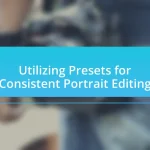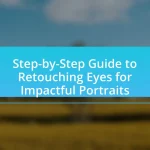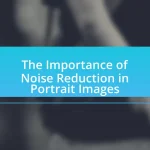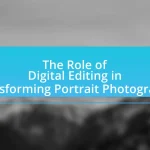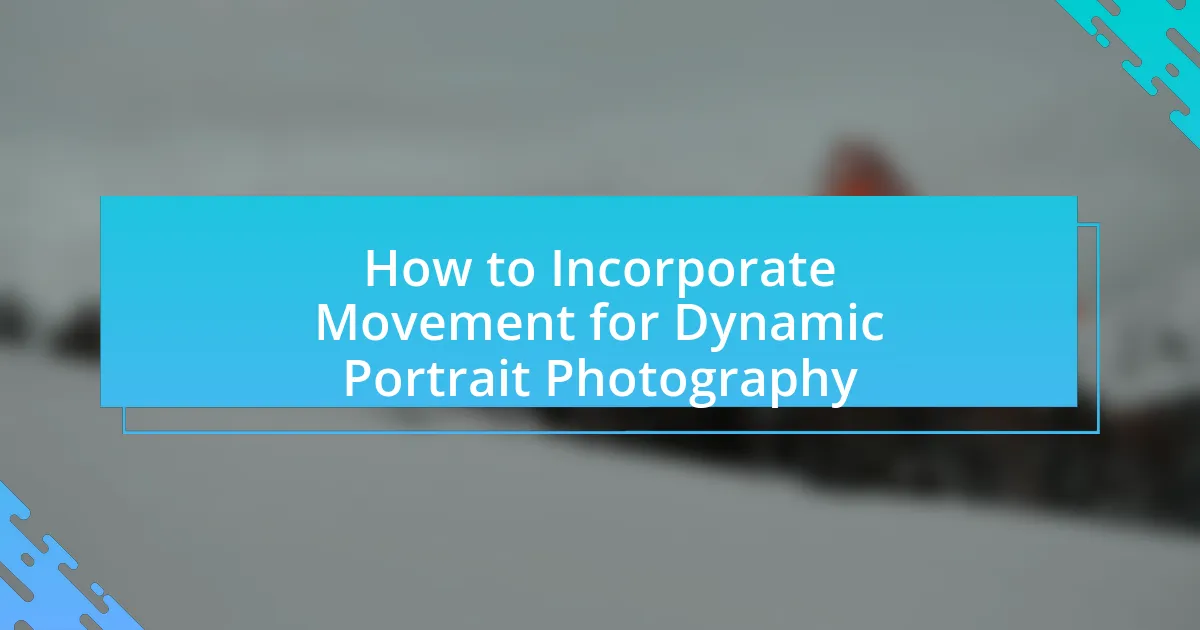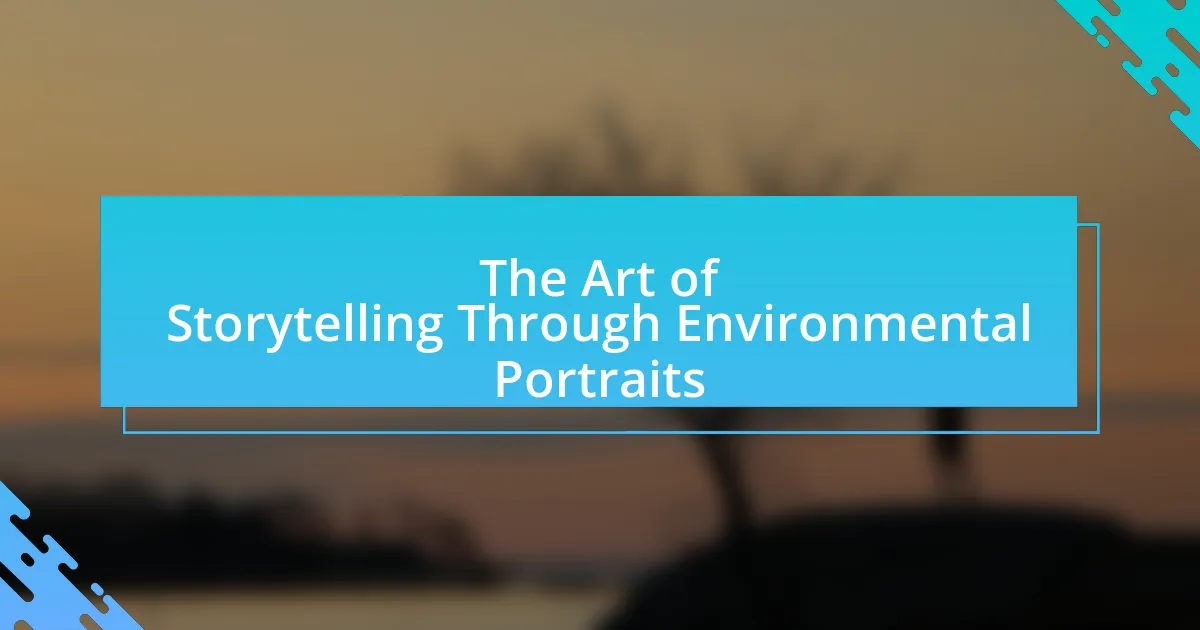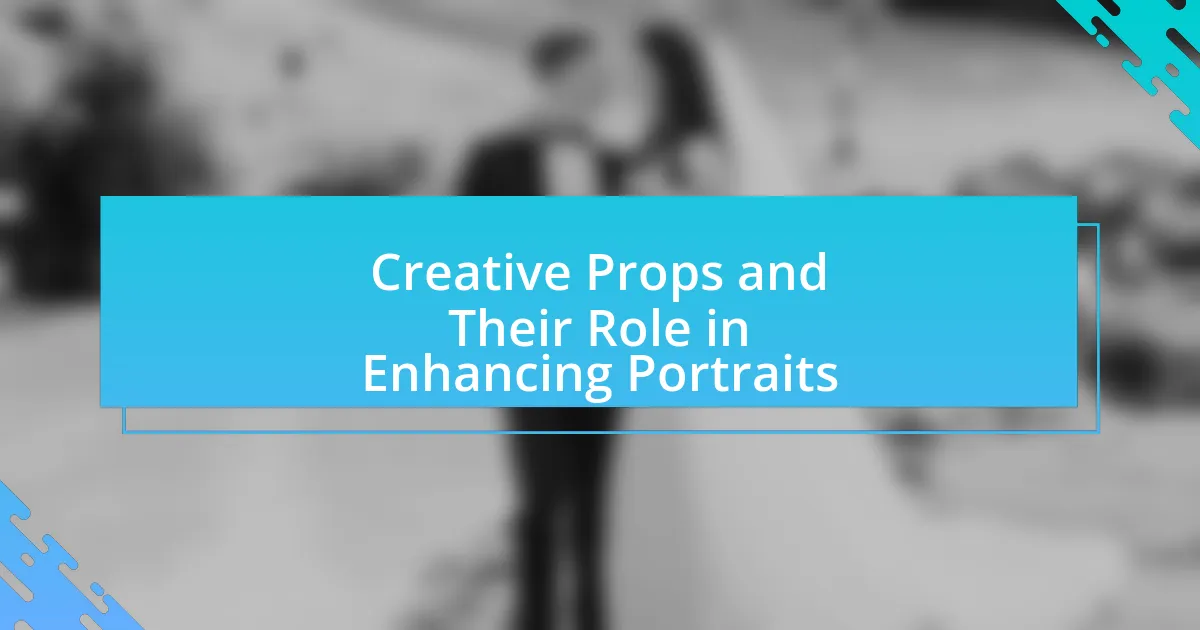The article explores the intersection of fashion and portrait photography, highlighting their shared focus on capturing individual essence while emphasizing style and aesthetics. It discusses how these genres complement each other through artistic representation and emotional expression, tracing their historical connections and evolution. Key elements such as lighting, composition, and styling are examined, along with current trends influenced by digital technologies and social media. The article also addresses ethical considerations, representation, and best practices for photographers, providing insights into techniques essential for successful fashion portrait photography.

What is the Intersection of Fashion and Portrait Photography?
The intersection of fashion and portrait photography lies in their shared focus on capturing the essence of individuals while emphasizing style and aesthetics. Fashion photography often highlights clothing and accessories, while portrait photography centers on the subject’s personality and expression. Both genres utilize similar techniques such as lighting, composition, and posing to create visually compelling images that convey a narrative. This blending of disciplines allows for the portrayal of fashion not just as a product but as an integral part of personal identity, as seen in the works of photographers like Richard Avedon and Annie Leibovitz, who have successfully merged these two forms to create iconic imagery.
How do fashion and portrait photography complement each other?
Fashion and portrait photography complement each other by merging the artistic representation of clothing with the emotional expression of individuals. This synergy allows fashion photography to showcase garments in a way that highlights the personality and character of the model, while portrait photography captures the essence of the subject, enhancing the storytelling aspect of fashion. For instance, iconic fashion photographers like Richard Avedon and Annie Leibovitz have effectively combined these styles, creating images that not only display fashion but also evoke strong emotional responses, thus reinforcing the narrative behind the clothing.
What are the historical connections between fashion and portrait photography?
Fashion and portrait photography have historically been interconnected through their mutual influence on visual culture and societal norms. In the 19th century, the advent of photography allowed for the documentation of fashion trends, as seen in the works of photographers like Charles Frederick Worth, who is often regarded as the father of haute couture. Worth’s designs were frequently captured in portraits, establishing a link between the clothing and the identity of the subject.
Furthermore, the rise of magazines in the early 20th century, such as Vogue, showcased fashion photography as a distinct genre, merging the art of portraiture with the promotion of fashion. Photographers like Edward Steichen and Richard Avedon played pivotal roles in this evolution, using portrait photography to elevate fashion to an art form, thus reinforcing the connection between personal identity and style.
This historical relationship illustrates how fashion photography not only reflects trends but also shapes perceptions of beauty and status, making it a crucial element in the narrative of portrait photography.
How has the evolution of fashion influenced portrait photography styles?
The evolution of fashion has significantly influenced portrait photography styles by dictating the aesthetics, poses, and themes captured in photographs. As fashion trends have shifted from the elaborate garments of the 18th century to the minimalist styles of the 21st century, portrait photography has adapted to reflect these changes, showcasing the latest trends and cultural movements. For instance, the introduction of ready-to-wear clothing in the mid-20th century led to more casual and candid portrait styles, moving away from the formal poses of earlier eras. Additionally, the rise of fashion photography in the 1920s, exemplified by photographers like Edward Steichen, integrated high fashion into portraiture, emphasizing the relationship between the subject’s attire and their identity. This interplay continues today, as contemporary photographers often collaborate with fashion designers to create visually striking portraits that highlight current fashion trends.
Why is the intersection of these two fields significant in contemporary art?
The intersection of fashion and portrait photography is significant in contemporary art because it challenges traditional boundaries and redefines visual storytelling. This fusion allows artists to explore identity, culture, and consumerism, reflecting societal changes and personal narratives. For instance, photographers like Richard Avedon and Annie Leibovitz have utilized this intersection to create iconic images that not only showcase fashion but also convey deeper emotional and social contexts, thus elevating the medium of photography to an art form that engages with contemporary issues.
What cultural impacts arise from blending fashion and portrait photography?
Blending fashion and portrait photography creates significant cultural impacts by shaping societal perceptions of beauty and identity. This fusion allows for the exploration of diverse aesthetics and narratives, reflecting and challenging cultural norms. For instance, the rise of social media platforms has democratized fashion photography, enabling marginalized voices to redefine beauty standards and promote inclusivity. Research by the Pew Research Center indicates that 72% of teens use social media, which influences their views on fashion and self-image, highlighting the role of these blended genres in contemporary culture. Additionally, iconic collaborations, such as those between fashion designers and portrait photographers, have historically influenced trends, as seen in the works of Richard Avedon and Vogue, which have set benchmarks for visual storytelling in fashion.
How does this intersection reflect societal trends and values?
The intersection of fashion and portrait photography reflects societal trends and values by showcasing evolving standards of beauty and identity. This convergence highlights the increasing importance of individual expression and diversity in contemporary culture, as seen in campaigns that feature models of various ethnicities, body types, and gender identities. For instance, the rise of body positivity movements has influenced fashion photography to embrace authenticity over traditional ideals, as evidenced by brands like Aerie and Savage X Fenty, which prioritize inclusivity in their marketing strategies. This shift not only mirrors societal demands for representation but also reinforces the value placed on personal narratives and self-acceptance in modern society.
What are the key elements that define this intersection?
The key elements that define the intersection of fashion and portrait photography include composition, lighting, styling, and emotional expression. Composition involves the arrangement of subjects and background to create visually appealing images, while lighting is crucial for setting the mood and highlighting details in both fashion and portraiture. Styling encompasses clothing, accessories, and overall aesthetics that reflect current fashion trends, and emotional expression captures the subject’s personality, enhancing the narrative of the photograph. These elements work together to create impactful images that resonate with viewers and convey the essence of both fashion and portrait photography.
What role does lighting play in fashion portrait photography?
Lighting is crucial in fashion portrait photography as it shapes the mood, highlights the subject’s features, and enhances the overall aesthetic. Proper lighting techniques, such as using soft light for a flattering effect or dramatic shadows for intensity, can significantly influence how clothing and accessories are perceived. For instance, high-key lighting creates a bright and airy feel, often used in fashion editorials, while low-key lighting can evoke a sense of mystery and sophistication. Studies show that lighting can alter the viewer’s emotional response to an image, making it a fundamental element in conveying the intended message of the fashion portrait.
How do composition and styling differ in fashion versus traditional portrait photography?
Composition and styling in fashion photography prioritize visual impact and trend representation, while traditional portrait photography focuses on capturing the subject’s personality and emotion. In fashion photography, composition often employs dynamic angles, bold colors, and dramatic lighting to highlight clothing and accessories, aiming to create an aspirational aesthetic. Conversely, traditional portrait photography typically utilizes softer lighting, straightforward compositions, and neutral backgrounds to emphasize the subject’s features and expressions, fostering a sense of intimacy. This distinction is evident in the work of renowned fashion photographers like Steven Meisel, who often experiment with unconventional framing, compared to portrait photographers like Annie Leibovitz, who emphasize storytelling through direct engagement with the subject.

What are the Current Trends in Fashion and Portrait Photography?
Current trends in fashion and portrait photography include the rise of authenticity, with a focus on natural lighting and candid moments, as well as the integration of technology through digital manipulation and augmented reality. Photographers are increasingly prioritizing diverse representation, showcasing models of various backgrounds, body types, and ages to reflect societal changes. Additionally, the use of social media platforms for sharing and promoting work has become essential, influencing styles and trends in real-time. According to a 2022 report by the International Center of Photography, 70% of photographers noted that social media significantly impacts their creative direction and audience engagement.
How are digital technologies shaping these trends?
Digital technologies are significantly shaping trends in fashion and portrait photography by enhancing accessibility, creativity, and efficiency. The rise of high-quality digital cameras and smartphones has democratized photography, allowing more individuals to capture professional-grade images. Additionally, software advancements in editing tools, such as Adobe Photoshop and Lightroom, enable photographers to manipulate images with precision, fostering innovative styles and techniques. Data from the 2021 “State of Photography” report indicates that 75% of photographers now use digital editing software, highlighting its integral role in modern photography practices. Furthermore, social media platforms like Instagram serve as vital channels for showcasing work, influencing trends and consumer preferences in real-time. This interconnectedness between technology and photography continues to evolve, driving new trends and techniques in the industry.
What impact do social media platforms have on fashion portrait photography?
Social media platforms significantly influence fashion portrait photography by providing a global stage for exposure and engagement. These platforms enable photographers to showcase their work to a vast audience, leading to increased visibility and opportunities for collaboration. For instance, Instagram, with over 1 billion active users, serves as a primary medium for fashion photographers to share their portfolios, connect with brands, and attract clients. Additionally, the rise of influencer culture on social media has transformed how fashion portrait photography is created and consumed, as influencers often dictate trends and aesthetics that photographers adopt. This dynamic interaction between social media and fashion portrait photography fosters innovation and rapid evolution in styles and techniques, making it a crucial element in the contemporary fashion landscape.
How are photographers utilizing new editing software to enhance their work?
Photographers are utilizing new editing software to enhance their work by leveraging advanced features such as AI-driven tools, improved color grading, and enhanced retouching capabilities. These software solutions allow photographers to streamline their workflow, achieve more precise edits, and create visually striking images that align with current trends in fashion and portrait photography. For instance, AI tools can automate complex tasks like skin retouching and background removal, significantly reducing editing time while maintaining high-quality results. Additionally, software like Adobe Lightroom and Capture One offers sophisticated color grading options that enable photographers to achieve specific moods and styles, which are essential in the competitive fashion industry.
What styles are emerging in the fashion portrait photography scene?
Emerging styles in the fashion portrait photography scene include minimalism, vibrant color palettes, and mixed media approaches. Minimalism focuses on simplicity and clean lines, often utilizing negative space to emphasize the subject. Vibrant color palettes are gaining popularity, with photographers using bold hues to create striking visual narratives. Mixed media approaches combine photography with digital art, allowing for innovative storytelling and unique aesthetics. These trends reflect a shift towards more expressive and personalized representations in fashion portraiture, aligning with contemporary cultural movements that prioritize individuality and creativity.
How is minimalism influencing contemporary fashion portraits?
Minimalism is influencing contemporary fashion portraits by emphasizing simplicity and clarity in composition, which allows the subject to stand out without distractions. This approach often utilizes neutral color palettes, clean lines, and minimal props, focusing on the essence of the clothing and the model’s expression. For instance, fashion photographers like Peter Lindbergh have adopted minimalist styles that strip away excess, showcasing raw beauty and authenticity, which resonates with current consumer preferences for transparency and sustainability in fashion. This trend reflects a broader cultural shift towards valuing quality over quantity, as seen in the rise of minimalist brands that prioritize timeless designs over fast fashion.
What role does diversity play in current fashion photography trends?
Diversity plays a crucial role in current fashion photography trends by promoting inclusivity and representation across various demographics. This shift is evident as brands increasingly feature models of different ethnicities, body types, ages, and gender identities, reflecting a broader spectrum of society. For instance, a 2021 study by the fashion consultancy firm The Business of Fashion found that 67% of consumers prefer brands that showcase diversity in their advertising. This trend not only resonates with audiences but also drives engagement and sales, as consumers are more likely to connect with brands that represent their identities and experiences.
What are the ethical considerations in modern fashion portrait photography?
Ethical considerations in modern fashion portrait photography include issues of consent, representation, and the impact of digital manipulation. Photographers must obtain explicit consent from models, ensuring they understand how their images will be used, which aligns with ethical standards in the industry. Additionally, representation is crucial; photographers should strive for diversity and inclusivity, reflecting a broad spectrum of identities and body types to avoid perpetuating stereotypes. The use of digital manipulation raises concerns about authenticity and body image, as excessive alterations can contribute to unrealistic beauty standards. Studies indicate that exposure to digitally altered images can negatively affect viewers’ self-esteem and body image, highlighting the responsibility of photographers to present realistic portrayals.
How do photographers address issues of representation and body image?
Photographers address issues of representation and body image by intentionally diversifying their subjects and challenging conventional beauty standards. They often showcase a wide range of body types, ethnicities, and ages to promote inclusivity and authenticity in their work. For instance, campaigns like Aerie’s #AerieREAL have successfully featured unretouched images of models of various sizes, which has been shown to positively impact body image perceptions among viewers. Additionally, photographers may collaborate with models and communities to ensure that their narratives are accurately represented, thereby fostering a more holistic view of beauty that resonates with a broader audience.
What responsibilities do fashion photographers have towards their subjects?
Fashion photographers have the responsibility to ensure the comfort, safety, and dignity of their subjects during photo shoots. This includes creating a respectful environment, obtaining informed consent for the use of images, and being mindful of how the portrayal may impact the subject’s reputation and self-image. Additionally, photographers should communicate clearly with their subjects about the vision for the shoot and involve them in the creative process, fostering collaboration. These responsibilities are crucial as they help maintain ethical standards in the industry and promote positive experiences for models and other participants.
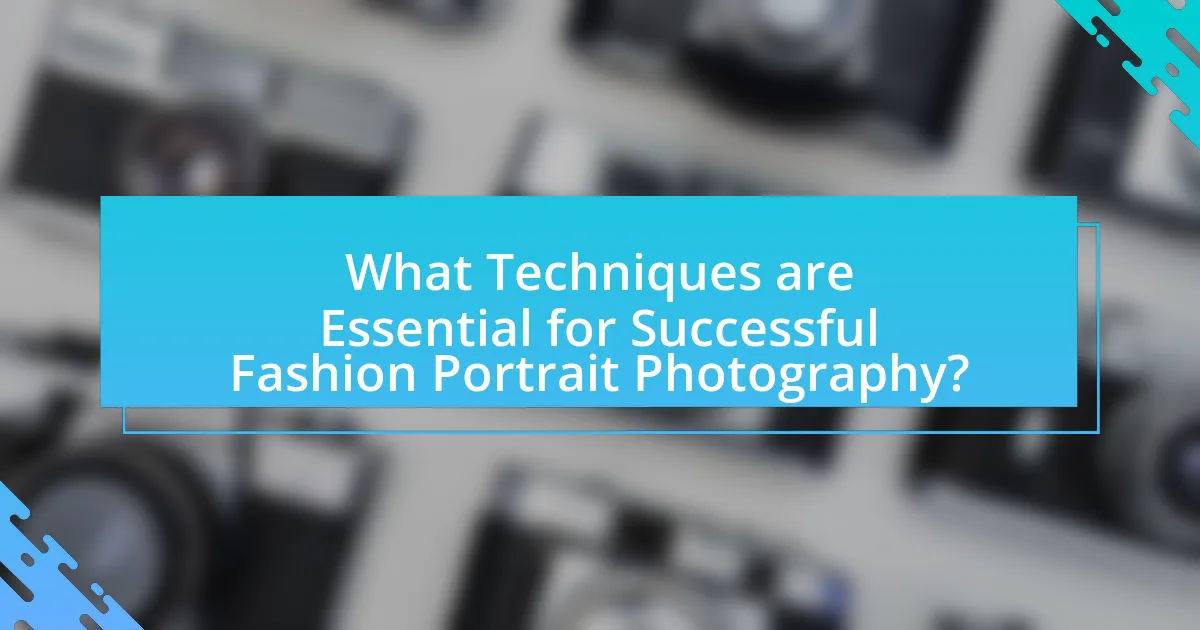
What Techniques are Essential for Successful Fashion Portrait Photography?
Successful fashion portrait photography relies on several essential techniques, including lighting, composition, and posing. Proper lighting, such as soft diffused light or dramatic shadows, enhances the subject’s features and creates mood, which is crucial in fashion photography. Composition techniques, like the rule of thirds or leading lines, guide the viewer’s eye and emphasize the model and clothing. Additionally, effective posing is vital; it should convey the desired emotion and showcase the fashion being photographed. These techniques are supported by industry standards, as seen in the works of renowned fashion photographers like Annie Leibovitz and Mario Testino, who utilize these methods to create compelling images that resonate with audiences.
How can photographers effectively plan a fashion portrait shoot?
Photographers can effectively plan a fashion portrait shoot by establishing a clear concept, selecting appropriate locations, and coordinating with models and stylists. A well-defined concept guides the overall aesthetic and mood, ensuring that all elements align with the desired outcome. Choosing locations that complement the fashion theme enhances visual storytelling, while collaboration with models and stylists ensures that wardrobe choices and poses reflect the intended style. Research indicates that pre-shoot planning, including mood boards and shot lists, significantly improves the efficiency and creativity of the shoot, leading to more successful outcomes.
What are the key steps in pre-production for a fashion portrait session?
The key steps in pre-production for a fashion portrait session include concept development, location scouting, casting models, wardrobe selection, and scheduling. Concept development involves defining the theme and style of the shoot, which sets the creative direction. Location scouting is essential for identifying suitable backdrops that complement the fashion being portrayed. Casting models ensures that the right individuals embody the desired aesthetic and appeal of the fashion. Wardrobe selection is critical for choosing outfits that align with the concept and enhance the overall visual impact. Finally, scheduling coordinates all elements, ensuring that the shoot runs smoothly and efficiently. Each of these steps is vital for a successful fashion portrait session, as they collectively contribute to the overall execution and quality of the final images.
How important is collaboration with stylists and models in this process?
Collaboration with stylists and models is crucial in the process of fashion and portrait photography. This partnership enhances the visual storytelling aspect, ensuring that the final images align with the intended artistic vision. Stylists contribute by selecting outfits and accessories that complement the theme, while models bring the clothing to life through their poses and expressions. Research indicates that effective collaboration can significantly improve the quality of the final product, as seen in successful campaigns where cohesive teamwork resulted in striking visuals that resonate with audiences.
What are the best practices for capturing compelling fashion portraits?
The best practices for capturing compelling fashion portraits include utilizing natural light, selecting dynamic poses, and incorporating strong styling elements. Natural light enhances the subject’s features and creates a soft, flattering effect, while dynamic poses add energy and movement to the image, making it more engaging. Strong styling elements, such as unique clothing and accessories, contribute to the overall aesthetic and narrative of the portrait. Research indicates that portraits with well-defined lighting and composition can significantly increase viewer engagement, as seen in studies on visual perception in photography.
How can photographers utilize natural light versus artificial lighting?
Photographers can utilize natural light by taking advantage of its soft, diffused qualities during golden hour, which enhances skin tones and creates flattering shadows. In contrast, artificial lighting allows photographers to control intensity, direction, and color temperature, enabling consistent results regardless of the time of day or weather conditions. For instance, using softboxes or reflectors can mimic natural light effects, while flash can freeze motion and illuminate subjects in low-light environments. This versatility in lighting techniques is crucial in fashion and portrait photography, where the desired mood and aesthetic can significantly impact the final image.
What techniques can enhance the emotional impact of a portrait?
Techniques that can enhance the emotional impact of a portrait include the use of lighting, composition, and color. Lighting can create mood; for instance, soft, diffused light often evokes tenderness, while harsh shadows can convey drama. Composition, such as the rule of thirds, directs the viewer’s focus and can emphasize the subject’s expression, enhancing emotional resonance. Color choices also play a crucial role; warm tones can evoke feelings of warmth and comfort, while cool tones may suggest sadness or introspection. Research indicates that these elements significantly influence viewer perception and emotional response, as demonstrated in studies on visual psychology.
What post-production techniques are commonly used in fashion portrait photography?
Common post-production techniques used in fashion portrait photography include retouching, color correction, and compositing. Retouching involves removing blemishes, smoothing skin, and enhancing features to achieve a polished look, which is essential in fashion to maintain high standards of beauty. Color correction adjusts the hues and tones to create a specific mood or aesthetic, ensuring that the colors of clothing and backgrounds are vibrant and true to life. Compositing combines multiple images or elements into a single frame, allowing for creative backgrounds or effects that enhance the overall composition. These techniques are widely adopted in the industry to produce visually striking images that align with fashion trends and branding requirements.
How do photographers balance retouching with maintaining authenticity?
Photographers balance retouching with maintaining authenticity by applying selective editing techniques that enhance the image while preserving the subject’s natural features. This approach often involves minor adjustments to lighting, color correction, and skin smoothing, which can improve the overall aesthetic without altering the subject’s true appearance. Research indicates that excessive retouching can lead to unrealistic portrayals, negatively impacting viewer perception and trust; therefore, many photographers adhere to industry standards that promote authenticity, such as the use of minimal retouching guidelines. This balance is crucial in fashion and portrait photography, where the goal is to showcase beauty while remaining true to the subject’s identity.
What software tools are most effective for editing fashion portraits?
Adobe Photoshop is the most effective software tool for editing fashion portraits due to its comprehensive features for retouching, color correction, and compositing. Photoshop offers advanced capabilities such as layer management, masking, and a wide range of filters that allow photographers to enhance skin tones, adjust lighting, and create artistic effects. Additionally, Adobe Lightroom is also highly effective for fashion portrait editing, providing excellent tools for batch processing, color grading, and exposure adjustments, which are essential for maintaining consistency across a series of images. Both tools are industry standards, widely used by professional photographers and editors, ensuring that they meet the high demands of fashion photography.
What tips can aspiring photographers follow to excel in fashion portrait photography?
Aspiring photographers can excel in fashion portrait photography by mastering lighting techniques, understanding composition, and developing a unique style. Effective lighting is crucial; using natural light or soft diffused artificial light can enhance the subject’s features and create a flattering atmosphere. Composition plays a vital role; applying the rule of thirds and experimenting with angles can lead to more dynamic images. Additionally, cultivating a personal style through consistent practice and exploration of different themes can set a photographer apart in a competitive field. These strategies are supported by industry standards, as successful fashion photographers often emphasize the importance of these elements in their work.

